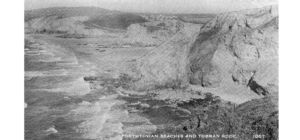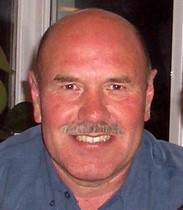 The treacherous cliffs at Porthtowan where the Rose of Devon foundered in 1897
The treacherous cliffs at Porthtowan where the Rose of Devon foundered in 1897
Clive Benney, St Agnes Old Cornwall Society Recorder, brings us the story of the demise of the Rose of Devon. The involvement of police constable Benney is particularly interesting as he was Clive’s great-grandfather.
One of the most tragic and disastrous wrecks known to Cornwall for a long time took place during the early hours of Monday, 29th November 1897 on the broad sandy beach at Porthtowan1. At this point the north coast is particularly dangerous, the mile after mile of high cliffs being only broken here and there by stretches of flat, treacherous sand.
All day on the Sunday before, the waves roared with tremendous fury and, where spectators could safely stand on commanding positions, they had magnificent views of unbroken water dashing great showers of spray far up the faces of the dark, steep cliffs. When the wind came more directly from the north it was feared by those on the lookout that some vessel would come to grief, but during the closing hours of Sunday night no distress signals were seen and it seemed that the numerous craft always running to and from the ports of South Wales had been able to weather the gale.
There was, however, a sad tale to be disclosed. When Coastguard West, who was stationed at Porthtowan, was on duty at about six o’clock on the Monday morning and the tide was nearing high water mark, he noticed amongst the foam a ship’s cistern. This left no room for doubt that a vessel had been wrecked, and, searching about in the dim light, he noticed the bodies of two men being driven before the waves on the side of the beach. Shortly after, there were discovered amongst the rocks on the western side of the beach, four other bodies. All except one had on belts bearing the name “Rose of Devon” and all were dead. While the bodies were being removed, large quantities of wreckage were driven in, and later there was observed, held fast in the sand two hundred yards below high-water mark, the remains of a barque. The bodies were conveyed to the house near the beach and searched but nothing was discovered to suggest who they were.
In neither case were the features of the dead disfigured to any extent, owing to the absence of rocks where they were driven in. Two were wearing oilskin coats, but the others had on only ordinary working garments. The finest man is nearly six feet high, strongly built, with a lightish moustache, and on his right wrist and hand a bracelet and anchor are tattooed. He has a wound over his right ear and on the forehead. Next to him lay a man of about sixty, of medium height, with beard and moustache turning grey. Then came a clean-shaven young man, about thirty, with delicate features and dark hair, who appeared to be the mate. By his side was one of the same age, with very dark brown moustache. Next was a young man of twenty-three, with dark hair; and the sixth was about thirty years old, with slight dark beard and moustache.
Chief Coastguard Vines, of Porthtowan, who came over in the morning, took charge of the bodies, and P C Benney, of St Agnes, who was early on the scene, communicated with the coroner, Mr Carlyon, with the result that the inquest was to be opened on Tuesday. It was ascertained that recently the Rose of Devon was owned by Mr Shilston, of Plymouth, but on a telegram being sent to him he replied that she now belonged to Mr Dorey, of Guernsey. During the day, Mr Dorey wired for all particulars of the vessel, which were supplied. When the tide receded, it was found that the vessel had broken in two, one half having been dashed to pieces, while the other half was held fast in the sand by the bow, which pointed seaward. Over the beach from one end to the other fragments of varying sizes were strewn, and those were eagerly collected by salvers, who flocked to the port through the morning. How the vessel came in is a mystery; by some it is believed that she was disabled a long way off to the north, quickly driven on to the beach, and that as soon as she touched she rolled over and over until the anchor got a hold in the sand.
The outhouse where the bodies were deposited early on Monday morning is far from a suitable place for the temporary resting place of the dead. It was a miserable old shed, in whose masonry walls are many holes that suggest an abundance of rats. The six bodies lay close together on the ground, without fresh straw or litter between them and the earth, whilst no attempts had been made to remove the sand and blood which gathered about the bodies.
The Inquest
Mr E L Carlyon held an inquest at Towan Cross, a mile or so from the scene of the wreck, into the circumstances surrounding the death of the six men. The Rev J Stona, of Mount Hawke, was chosen foreman of the jury.
The coroner stated that the Coastguards had received the following telegrams:
Guernsey, 7.48 p.m., November 29th – William Loveridge has woman tattooed on arm; also two hands clasping one another on the wrist. Wire if picked up or not. Loveridge, Crown Hotel, Guernsey.
Guernsey, 8.30 a.m., November 30th – Do not bury Loveridge. His father will fetch him as soon as possible. Will leave Guernsey in the morning. Loveridge, Crown Hotel, Guernsey.
Guernsey, 10.50 a.m., November 30th – Do not bury Machon. Representative left here today. Dorey.
James West, who stated that he was a coastguard at Porthtowan, gave evidence substantially the same as the above account of the finding of the bodies, and discovering the wreck.
The Rev J Stona: “You saw nothing to lead you to suppose there was a vessel in danger”.
“No, sir; nothing. I am positive there was no light, and nothing to be seen or heard until daylight, and then we could see what you can see now.”
The Rev J Stona: “Did you have any communication from either east or west?”
“No, and no one saw her from Portreath or St Agnes.”
The coroner, addressing the jury, said, “It seemed that this was one of those deplorable accidents sent by the hand of God. The men were out in a severe gale and driven on to the lee shore. By the coastguard they had been told that he saw no light during the night, though he was watching the whole night through. They might well suppose the lights were blown out, as was the case with the vessel whose crew was rescued under Gurnard’s Head.”
The jury returned a verdict of “Found drowned”.
A juror: “It is very disgraceful where the bodies are, and I should like them to be removed before any relatives came to see them.”
The coroner said they must complain to the overseers of the parish about that.
Coastguard West said they could be put in the adjoining house on the permission of Mr Goddard being obtained, but he did not think that would be safer as regarded vermin.
The coroner inquired whether the overseer had sent any coffins. P C Benney replied that he had not.
Coastguard West said that on the previous night they put a light there, but through an accident all the horn of the lantern was burnt.
A juryman: “The police ought to see that no accident happens to the bodies. The place is infested with rats.”
P C Benney pointed out that when they had informed the assistant overseer the matter went from the control of the police. Would the coroner recommend that the bodies be removed to the mortuary at St Agnes?
The coroner: “Yes: I do recommend their removal to the mortuary.”
P C Benney: “They object to the four found in Illogan Parish being removed to that mortuary because of the expense to this parish.”
The coroner: “It is immaterial to me where they are removed so long as they are looked after. The police had better see the overseers of both parishes.”
Coastguard West: “We passed the place at intervals last night and gave the door a good rap with a stick to frighten away the rats.”
The coroner thought the bodies might remain another day before being buried, for identification. “The police must see the bodies put into shells.” He dared say the owners of the vessel would bear the expense of the funerals. He did not suppose there would be any difficulty on that point.
 The remains of the Rose of Devon, the day after she was wrecked, November 1897
The remains of the Rose of Devon, the day after she was wrecked, November 1897
I thought it was the end of the story until February 1987 when I received an interesting letter from the late John H Trounson of Redruth. In the letter he told me that he had heard stories of the wreck from his father and of the public outcry before the bodies were eventually buried at Mount Hawke Church. “The ship itself had a fine figurehead which was acquired by the Nicholls family and displayed near the ‘White House’ on the beach. When the Nicholls family left the White House, the figurehead was re-erected in their nursery gardens at the top of Trewergie Hill, where the road divides into two, on to Buller Hill and the other past ‘Trewergie House’. There are greenhouses there now but for years the figurehead could be seen amongst the trees. It finally rotted away until the nose dropped off and the figure fell down. The wooden face without a nose looked awful.”
Nothing more is known of the figurehead, and the remains of the wreck apparently no longer emerge after scouring sea conditions. All evidence of the disaster, like the parish boundary itself, has now gone.
References
1 The West Briton, 2nd December 1897.

Clive Benney is a prolific researcher of Cornish history and an avid collector of St Agnes Parish postcards. He is the Vice-Chairman of St Agnes Museum Trust, the Recorder for St Agnes Old Cornwall Society, a Cornish Bard and the author of many books and articles.
